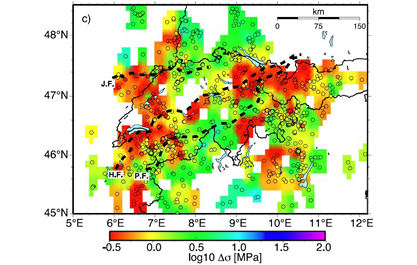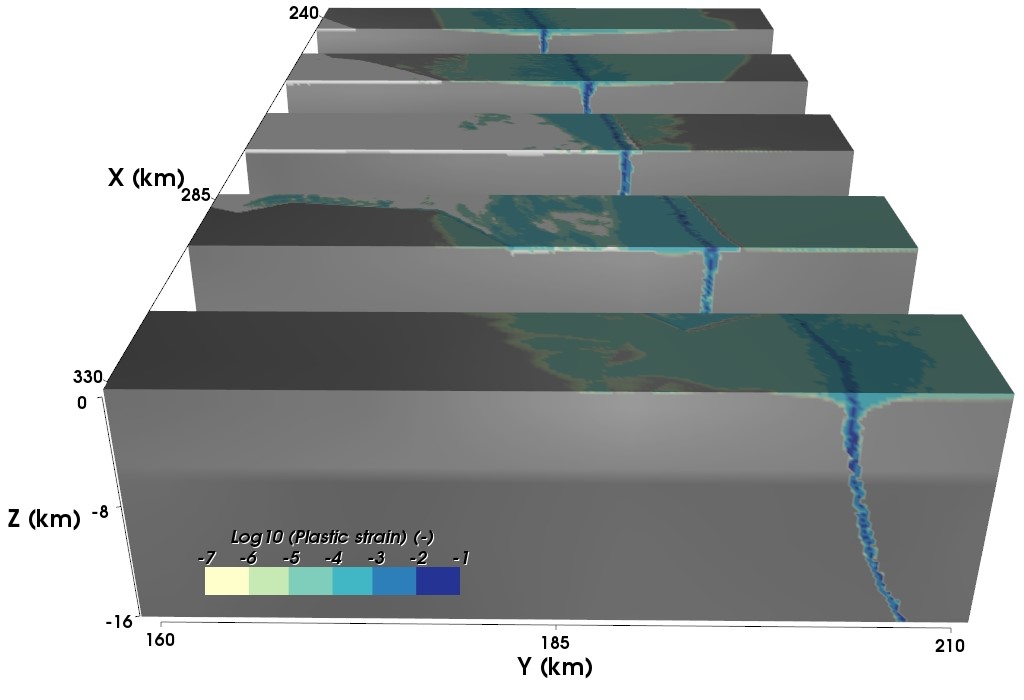Numerical Modeling of Earthquake Ground Motion
Earthquakes are modeled when there are no instrumental recordings, i.e. particularly for large, damaging earthquakes and sites close to seismic sources. One way of doing this is to calibrate site-specific ground motion attenuation models. Another is to use deterministic modeling of the rupture process and of wave propagation for scenario earthquakes. However, local geological properties must always be properly factored in.
Illustration: Spatial variation in the stress-drop parameter of instrumental earthquakes occurring in Switzerland in recent decades

Ground Motions for Typical and Extreme Earthquakes
Predicting earthquake-induced ground motion is a core element of both probabilistic and deterministic seismic hazard analysis. Correctly modeling ground motion is a real challenge, especially in light of the relatively few recordings made in the vicinity of the rupture, and also in the case of rare, large earthquakes.
There is substantial potential for improving how fundamental laws of physics are factored in when modeling ground motion. Such improvements can supposedly be made by combining site-specific ground motion attenuation models with deterministic modeling of the rupture process and wave propagation for realistic scenario earthquakes. Modeling can only be reliable if the models in question take account of the properties of the local geological underground.
Ground Motion Prediction Equations (GMPEs)
Typical waveforms are generated using simulation-based stochastic models and by describing the seismic source, wave propagation and influence of properties of the local site. Over the last few years, a model of this kind adapted for Switzerland has been developed, verified and applied for the Seismic Hazard Model for Switzerland. This model paves the way for many applications with recorded earthquake data, which are important for hazard analysis. Key improvements over the next few years will concern the source model used, the modeling of large earthquakes with expansive rupture surfaces, the introduction of alternative magnitudes to Mw, physical models for on-site attenuation, models for describing ground motion at depth, better descriptions of near-field effects, and enhanced methods for developing stochastic methods.
Scenario Modeling and Limits on Ground Motion
The aim of one sub-project is to model typical earthquake scenarios that can be expected to occur in Switzerland, based on the physics of the rupture process and complex wave propagation. Among other things, this entails simulating extreme events in the vicinity and ascertaining the physical limits on ground motion. For unconsolidated sediments on the surface, non-linear attenuation and material failure, like soil liquefaction, impose important limits on the maximum ground motion possible.
Significant advances have already been made in numerically simulating anelastic, plastic and non-linear behaviour, and this work is to be continued by incorporating the latest possibilities offered by 3D-modeling, which include heterogeneous rupture surfaces, simulations of variable material properties and the resulting dispersion of seismic waves, and the modeling of high frequencies.
Plastic deformations occurring at the rupture surface when strong earthquakes occur and in unconsolidated sediments (a magnitude 7.8 earthquake on the southern San Andreas Fault in California)
